Finite Element Analysis
I've been writing FEA codes since my junior undergraduate year. Since then
I have develop a wide range of 2D/3D finite element codes for both steady
state and transient problems. Some details are given below.

2D/3D Elastostatics/Heat Conduction/Thermoelasticity
I began work on this code when I started my Master's degree program in
1995. The main focus was to produce a code that could do thermoelastic
stress analysis of internally cooled turbine blades very quickly. At that
time our group was heavily involved in a project concerning the optimization
of internal coolant passages for turbine blades. Since the optimization
code might require hundreds or even thousands of analysis calls, it was
important that each analysis take the minimum amount of computation time
possible. I spent a lot of time developing iterative sparse equation
solvers as a replacement for the direct factorizations used in many FEA
codes. Use of such iterative methods resulted in a significant improvement
in speed and much lower core memory usage. Currently, the 3D stress/thermal
analysis of a realistic turbine blade with passages takes less than one
minute on a Pentium II PC.
Some features of the code:
Sparse solvers:
-
Preconditioned Krylov subspace methods(GMRES, CG, CGS,
BiCGSTAB)
-
ILU and multilevel preconditioners
-
LU Decomposition(direct solver)
-
Cholesky Decomposition(VSS from NASA Langley)
-
Multigrid(2D) for nested and solution adapted grids
-
Uses of the Enthalpy method to handle phase change for
simulation of melting/freezing
-
Can handle unsteady heat conduction problems with
nonlinear material properties
-
High speed, automatic, suitable for optimization
-
Objected-oriented, written in C++/C/FORTRAN
-
Triangular and Tetrahedral elements with a choice of
linear or quadratic basis functions
-
Element stiffness matrices integrated analytically
The 2D version of my code uses adaptive mesh refinement. Here's
an example for heat conduction:

Code Performance
11,000 DOF 3D Turbine Blade (Static): less than 1 min. on Pentium
200, around 15 sec. On SGI R10000
66,000 DOF 3D Turbine Blade (Static): approx. 10 min. on SGI R10000
11,000 DOF 3D Turbine Blade (Dynamic): approx. 5 min. for 100 time
steps on Pentium 200
Click on the images below to see a larger picture


3D Structural Dynamics
I also wrote an FEA code for 3D structural dynamics. Currently, this
code has not been used in any projects. It may eventually be used
for aeroelastic simulations of turbomachinery blades. Click on the
links below to see some animation of structural dynamics results produced
with my code.
Vibrating
Beam
Blade
Blade2
Blade
with Passages
Blade
with Passages 2

Inverse detection of boundary conditions in 2D thermoelasticity
I developed a finite element algorithm for the inverse detection of unknown
boundary conditions for Laplace and Navier equations. I also implemented
this algorithm in my 2D thermoelastic finite element code. Below is an
example of a forward and inverse heat conduction analysis of an annual
region with 16 internal circular cavities. In the well-posed or forward
problem, a Dirichlet boundary condition is applied on all boundaries. But
in the inverse problem, both the Dirichlet and Neumann boundary conditions
are applied to outer circular boundary while no boundary conditions are
applied to the internal cavities. The inverse FEA code is able to accurate
predict the temperature distribution throughout the entire domain, even
on the internal boundaries.
Click on the images below to see larger pictures
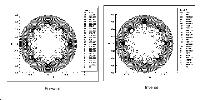
Well-posed(forward) and inverse analysis
|
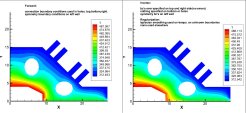
Well-posed(forward) and inverse analysis
|

2D Incompressible Navier Stokes/Euler with LSFEM
In the spring of 1999, I began developing several 2D fluid mechanics codes
using the Least-Squares Finite Element method (LSFEM).
Advantages of the LSFEM
-
Can use equal order basis functions for pressure and
velocity
-
No free parameters to tune
-
can use the first order form of PDE’s
-
can handle any type of equation and mixed types of
equations
-
Can discretize convection terms without upwinding or
explicit artificial dissipation
-
Clean and robust method
-
Resulting system of equations is symmetric and positive
definite
-
Simple iterative techniques and multigrid can be used
to solve the system of equations
-
Easy to construct high order approximations via
P-methods
-
rigorous convergence theory exists
-
strong mathematical background
-
Always leads to a minimization problem rather than saddle point problem
(interpolation function do not need to satisfy LBB condition)
Below is an example of low speed inviscid, rotation flow (Euler equations)
over a circle computed with a finite volume based code and with my LSFEM
code. One can see that upwinding require by the FVM code for stability
creates a noticeable asymmetry in the pressure field. My LSFEM code produces
a perfectly symmetric pressure field that matches the analytic solution
obtained from potential flow theory.
Click on the image below to see a larger picture
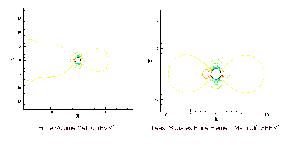
Comparision of FVM and LSFEM for Euler flow around a circle
|
Below is an example of viscous incompressible flow though a sudden expansion
at a Reynolds number of 450.
Click on the image below to see a larger picture

Viscous flow through a sudden expansion for Re=450 |

2D Magneto-Hydrodynamics with Conjugate Heat Transfer with LSFEM
Recently I have developed a 2D code to simulate magneto-hydrodynamics with
conjugate heat transfer.
This code was used to study the effect of an applied magnetic field
to the heat transfer (conductive and convective) characteristics of an
incompressible, electrically conducting fluid such as seawater.
Conjugate heat transfer problems involve the simultaneous prediction
of heat transfer in both the fluid field and the solid wall surrounding
the fluid. An example would be a cooled metal pipe carrying a hot
liquid.
In this example, a "horse-shoe" magnet is placed between the X coordinates
7 and 8. In this region, it can be see that the wall temperature
changes dramatically, depending on the strength of the magnetic field.
It can also be seen that the applied magnetic field generates a complex
vortex structure in the flow field. Also, when the magnetic Reynolds number
is high (such as when the fluid has a very high coefficient of electrical
conductivity), the interaction between the magnetic field and the moving
fluid can cause the magnetic field lines to sway in the downstream conditions.
This indicates that in MHD problems with high magnetic Reynolds numbers,
the Maxwell's equations should always be solved together with the Navier-Stokes
equations, either simultaneously or iteratively.
Click on the images below to see a larger picture
 Magnetic field lines in the presence of a moving fluid with low
electrical conductivity(seawater)
Magnetic field lines in the presence of a moving fluid with low
electrical conductivity(seawater)
|
 Temperatures along solid/fluid interface for various magnetic field
strengths
Temperatures along solid/fluid interface for various magnetic field
strengths
|
 Vortices induced by the presence of a strong magnetic field
Vortices induced by the presence of a strong magnetic field
|

Magnetic field lines in the presence of a highly electrically conductive
moving fluid
|

2D Electro-Magneto-Hydrodynamics with LSFEM
Recently I have developed a 2D code based on LSFEM to simulate electro-magneto-hydrodynamics.
This code was used to simulate the pumping of an electrically conducting
liquid such as sea water or blood.
In the example shown here,an electric and magnetic field are used pump
an electrically conducting incompressible viscous liquid through a channel
of height 4 cm and length 40 cm. A a uniform magnetic field of .05 Tesla
is applied in the Z direction. A positive electrode is placed at
the top of the wall and a negative electrode placed at the bottom of the
wall. A potential of 50 Volts applied across the electrodes.A parabolic
velocity profile was specified at the inlet and a pressure of 1 Pa was
specified at the outlet. The inlet temperature was 311 K and the wall temperature
was 300 K
This is a steady state calculation(no time derivatives).
Click on the images below to see a larger picture
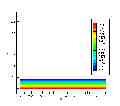
Computed electric potential
|
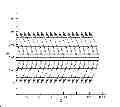
Computed velocity vectors |
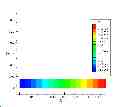
Computed static pressure |

Computed static temperature |
One can see from the above images that the application of a crossed electric
and magnetic field results in a pressure increase from the channel inlet to
outlet. Without either field, the pressure would decrease from inlet to
outlet due to the viscosity of the liquid. The Joule heating of the
liquid(due to the flow of electric current through the liquid) can also be seen.

2D Electro-Magneto-Hydrodynamics with p
-version LSFEM
Recently I have developed a 2D code based on p-version LSFEM to simulate
electro-magneto-hydrodynamics. This code was used to simulate the solidification
of silicon crystals with and without an applied magnetic field.
The p-version LSFEM was implemented using hierarchical basis
functions based on Jacobi polynomials. The hierarchical basis leads to a linear
algebraic system with a natural multilevel structure that is well suited to
adaptive enrichment. The sparse linear systems were solved by either direct
sparse LU factorization or by iterative methods. Two iterative methods were
implemented in the software, one based on a Jacobi preconditioned conjugate
gradient and the another based a multigrid-like technique that uses the
hierarchy of basis functions instead of a hierarchy of finer grids. The method
was implemented in an object-oriented fashion using the C++ programming
language. The software has been tested against analytic solutions and
experimental data for Navier-Stokes equations and for channel flows through
transverse electric and magnetic fields, for shear-driven cavity flows,
buoyancy-driven cavity flows, and flow over a backward-facing step.
In the example shown here, a crucible for the production of silicon crystals is simulated with and without an applied uniform magnetic field in the vertical
direction. The magnetic field strength is 1 Tesla.
This is a steady state calculation(no time derivatives).
Click on the images below to see a larger picture
|
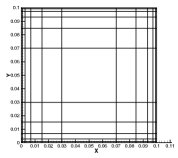
Computational mesh |
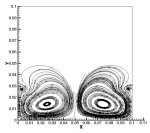
Computed streamlines with no magnetic field and
microgravity (1% of full gravity) |
 Computed streamlines with no magnetic field and full gravity
Computed streamlines with no magnetic field and full gravity
|
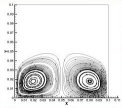
Computed
streamlines with magnetic field and full gravity |
One can see from the above images that the application of
uniform magnetic field in the vertical direction can significantly alter the
flow field melt region of the crucible.
The computational results indicate significantly different flow-field
patterns and thermal fields in the melt and the accrued solid in the cases of
full gravity, reduced gravity, and an applied uniform magnetic field. Although
the magnetic field significantly reduces the velocity of the flow within the
melt, the crystal may still be slightly contaminated.

![]()
![]()
![]()
![]()

![]()
![]()

![]()
![]()